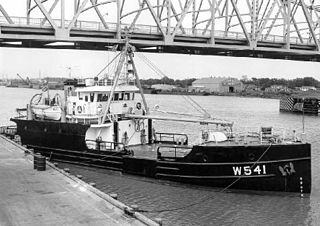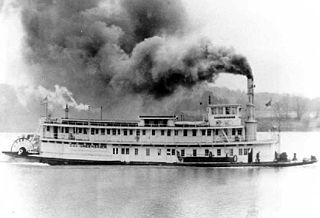
The USCG seagoing buoy tender is a type of United States Coast Guard Cutter used to service aids to navigation throughout the waters of the United States and wherever American shipping interests require. The U.S. Coast Guard has maintained a fleet of seagoing buoy tenders dating back to its origins in the U.S. Lighthouse Service (USLHS). These ships originally were designated with the hull classification symbol WAGL, but in 1965 the designation was changed to WLB, which is still used today.

USCGC Mesquite (WAGL/WLB-305) was the lead ship in the Mesquite class of seagoing buoy tenders operated by the United States Coast Guard. She served in the Pacific during World War II, and spent the rest of her Coast Guard career in the Great Lakes. She ran aground and was wrecked in December 1989 off the Keweenaw Peninsula in Lake Superior. She was scuttled nearby as a recreational diving attraction.

The USCGC Conifer was a 180 foot seagoing buoy tender. Conifer and her sister ships, commonly referred to as "one-eighties", served as the backbone of the Coast Guard's Aids to Navigation fleet for over 50 years before their replacement by the newer Juniper-class cutters.

USCGC Spar (WLB-206) is a United States Coast Guard Juniper-class seagoing buoy tender home-ported in Duluth, Minnesota. The ship maintains aids to navigation in the Twin Ports and Great Lakes.

USCGC Maple (WLB-207) is a Juniper-class seagoing buoy tender operated by the United States Coast Guard. She was based at Sitka, Alaska for 16 years and is currently homeported at Atlantic Beach, North Carolina. Her primary mission is maintaining aids to navigation, but she also supports search and rescue, law enforcement, oil spill response, and other Coast Guard missions.

The USCGC White Alder (WLM/WAGL-541) was the former Navy lighter, YF-417. The United States Coast Guard acquired a total of eight of these former Navy YF-257-class lighters between 1947-1948 for conversion to coastal buoy tenders. They were needed to complement the larger seagoing buoy tenders in servicing short-range-aids-to-navigation, typically those placed in coastal waters and harbors.

The USCGC Evergreen was a Cactus-class seagoing buoy tender operated by the United States Coast Guard. She served in the North Atlantic during World War II and participated in the International Ice Patrol in these waters after the war. She was the first dedicated oceanographic vessel in the Coast Guard's history. She was decommissioned in 1990 and sunk by the US Navy for target practice in 1992.

The USCGC Greenbrier was a stern paddlewheel steamer that was used as a river tender, first by the United States Lighthouse Service and then by the United States Coast Guard.

USCGC Elm (WLB-204) is a U.S. Coast Guard Juniper-class seagoing buoy tender home-ported in Astoria, Oregon. She is responsible for maintaining aids to navigation on the coasts of Oregon and Washington, including the Columbia River.

USCGC Smilax (WAGL/WLIC-315) is a 100-foot (30 m) United States Coast Guard Cosmos-class inland construction tender, commissioned in 1944. Smilax is the "Queen of the Fleet", as the oldest commissioned U.S. Coast Guard cutter.

USCGC Aspen (WLB-208) is the eighth cutter in the Juniper-class 225 ft (69 m) of seagoing buoy tenders. She is under the operational control of the Commander of the Eleventh U.S. Coast Guard District and is home-ported at Yerba Buena Island in San Francisco, California. Her primary area of responsibility is the coastal waters, river bars and high seas from the California–Oregon border to San Diego, California. Aspen conducts heavy lift aids-to-navigation operations, and law enforcement, homeland security, environmental pollution response, and search and rescue as directed.
USCGC Acacia (WAGL-200) was originally built for service by the U.S. Army as a mine planter shortly after World War I and later transferred to the U.S. Lighthouse Service, which became part of the U.S. Coast Guard in 1939; when transferred the ship was redesignated as a Speedwell-class buoy tender. She was sunk in 1942 by a German U-boat.

USCGC Ida Lewis (WLM-551) is the lead ship of the United States Coast Guard Keeper-class of Coastal Buoy Tenders. Launched in 1995, she has spent her entire career maintaining navigational aids near her homeport of Newport, Rhode Island.

USCGC Ironwood (WAGL-297/WLB-297) was a Mesquite-class sea-going buoy tender operated by the United States Coast Guard. She served in World War II, the Korean War, and the Vietnam War as well as a variety of domestic missions. She currently serves as a seamanship training vessel for Job Corps.

USCGC Buttonwood (WAGL-306/WLB-306) was a Mesquite-class sea-going buoy tender operated by the United States Coast Guard. She served in World War II as well as a variety of domestic missions. After decommissioning she was acquired by the Dominican Republic Navy and renamed Almirante Didiez Burgos. She is still active as the flagship of the Dominican Navy.

USCGC Planetree (WAGL/WLB-307) was a Mesquite-class seagoing buoy tender operated by the United States Coast Guard. She served during World War II, the Korean War, and the Vietnam War, as well as in a variety of domestic missions.

USCGC Elderberry (WLI-65401) is an inland buoy tender of the United States Coast Guard. She is based at Petersburg, Alaska and is responsible for maintaining aids to navigation. Her efforts are focused on waterways that are especially shallow or restricted.
USCGC Barberry (WLI-294) is a United States Coast Guard buoy tender that was donated to the state of Maryland in 1971. Based out of two locations in North Carolina and then Portsmouth, Virginia, during her Coast Guard career, the vessel was then used as an icebreaker by the Maryland Department of Natural Resources. In 2020, the Maryland Department of Natural Resources announced that the vessel would be replaced; her replacement is expected to be commissioned in 2022.

















